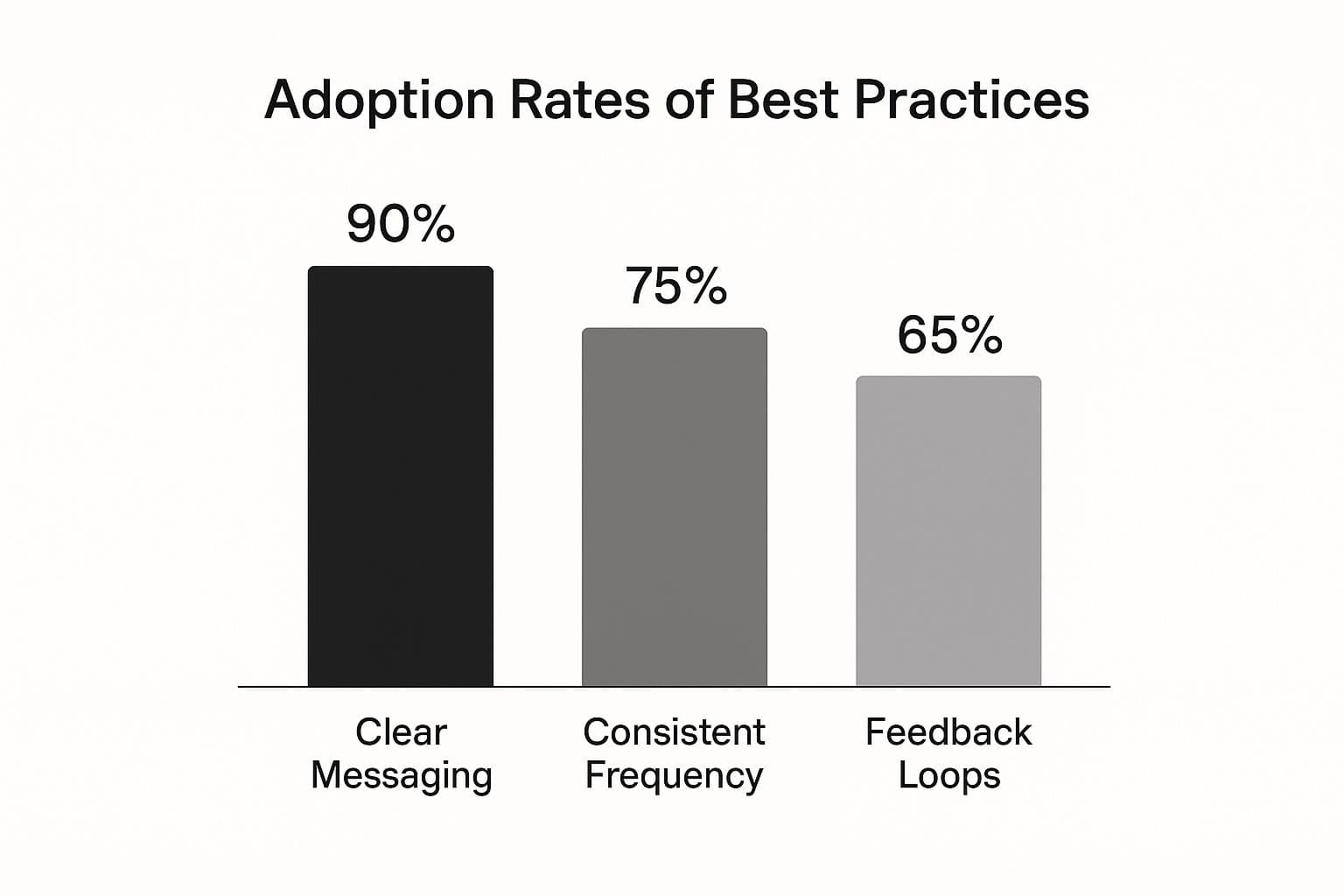Executive communication is how leaders turn a company's big-picture strategy into something everyone can act on. It’s far more than just making announcements or giving speeches. It’s the craft of creating absolute clarity, building deep-seated trust, and getting the entire organization pointed in the same direction, all working toward a shared goal.
What Is Executive Communication Really About
Think of a CEO as the conductor of an orchestra. They don’t play every instrument, but their job is to make sure every section—from engineering to marketing—plays in perfect harmony. When they succeed, the result is a masterpiece. That’s the heart of executive communication. It's the thoughtful use of words, tone, and even body language to guide the company, mold its culture, and ultimately, drive results.
This isn't just a soft skill anymore; it's a core leadership function. Today's leaders use it to steer the ship through major changes, keep employees engaged and motivated, and build an organization that can weather any storm.
It’s Not Just About Talking
At its core, executive communication is a blend of several skills that go way beyond just being a good public speaker. It’s a whole set of activities designed to make sure messages aren't just heard but are truly understood and, most importantly, acted upon.
This includes things like:
- Turning Vision into Action: Breaking down lofty corporate goals into clear, tangible objectives that every single person can see how they contribute to.
- Creating Alignment: Making sure all departments and teams are rowing in the same direction, guided by a consistent and compelling story from the top.
- Navigating Change: Leading the organization through tough transitions, mergers, or crises with honesty and empathy that directly addresses what people are worried about.
- Molding the Culture: Deliberately using communication to reinforce company values, celebrate successes, and build an environment where people feel safe and trusted.
The strategic weight of this role has exploded in recent years. The days of the communications team being a simple support function are long gone. A 2023 global study of Fortune 500 executives found that communications leaders are now critical strategic advisors who help shape both corporate strategy and public conversations on major issues. You can dive into the full findings on the future of corporate communications to see just how much has changed.
This table breaks down the core components that make executive communication so effective.
Core Components of Executive Communication
Mastering these components is what separates a good speaker from a true leader.
The Strategic Layers of Communication
Great executive communication works on several levels at once. It’s not just about what you say, but how, when, and to whom you say it.
A helpful way to think about it is in three distinct layers. The first is informational—giving people the "what" and "why" behind decisions. The second layer is inspirational, which connects the company’s mission to people’s daily work and gets them excited to contribute.
Finally, the third layer is relational. This is all about building trust and connection through genuine conversation and listening. A leader who can hit all three layers can turn a standard company update into a powerful moment that aligns and motivates the entire organization.
Why Great Executive Communication Drives Success

Let's get one thing straight: effective leadership communication isn’t just a "soft skill" or some corporate buzzword. It's the engine that powers a successful business. It’s what turns abstract strategies into real-world results, directly influencing everything from employee morale to your bottom line. When leaders communicate with real clarity and conviction, they create an environment where people can truly thrive.
Think of your company as a ship. The executive team points it toward a destination, but it’s their communication that acts as the rudder. Clear, consistent messaging ensures everyone on board—from engineering to sales—knows where you're headed and why. It makes sure everyone is rowing in the same direction.
The Real-World Impact of Clear Messaging
When leaders nail their communication, you can feel the positive effects ripple through the entire organization. It’s the difference between a team that just shows up and a team that’s genuinely all in. That commitment translates into tangible, measurable wins.
- Sky-High Employee Engagement: People who understand the company’s vision and see how their work connects to it are naturally more motivated. Great communication makes work feel meaningful.
- A Huge Productivity Boost: When everyone knows the priorities, they stop wasting time on conflicting tasks or second-guessing decisions. This kind of alignment is a direct result of clear leadership.
- A More Resilient Culture: A culture built on trust and transparency can weather any storm. When leaders are open and honest, especially during tough times, they build a workforce that's resilient and adaptable.
This isn't just theory; the data backs it up. Companies that get communication right see a staggering 72% increase in productivity among their leaders and a 56% jump in work satisfaction for their knowledge workers. You can see the full picture by exploring more workplace communication statistics.
The Staggering Price of Poor Communication
On the flip side, a lack of clear executive communication creates a vacuum. That void quickly fills with confusion, mistrust, and inefficiency, silently sinking even the best-laid plans.
And the cost? It’s massive. U.S. businesses lose an estimated 1.2 trillion annually** due to communication breakdowns. That works out to about **12,506 per employee, per year. These aren't just abstract numbers; they represent real consequences.
When communication fails, the warning signs are obvious: stalled projects, missed deadlines, and a revolving door of frustrated employees. Morale plummets and drains the organization’s energy. You can learn how to improve team communication with easy tips for success and steer clear of these problems.
A Tale of Two Companies
Let’s look at a simple example.
Company A: Thriving with Clarity
The CEO kicks off every quarter with a sharp all-hands meeting, laying out three core priorities. Simple. Department heads then echo that message in their own team huddles. When a market disruption hits, the CEO is on video immediately, transparently explaining the challenge and the plan. The result? Employees feel secure, aligned, and empowered to make smart decisions.
Company B: Struggling with Mixed Messages
Here, the leadership team is mostly silent. Big strategic shifts are announced in a dense, jargon-packed email that leaves everyone scratching their heads. Different execs give conflicting directions, creating friction and wasting resources. This breeds a culture of rumors and anxiety, and it’s not long before top talent starts heading for the exits.
The contrast couldn't be clearer. Executive communication isn't optional—it's the fundamental skill that turns a vision into reality.
The Four Pillars of Powerful Leadership Messaging

When you strip away the theory, executive communication really boils down to four fundamental pillars. Think of them as the legs of a table—if one is wobbly or missing, the whole thing comes crashing down. A leader's vision needs a sturdy platform to connect with their team's actions, and these pillars provide that foundation.
The four pillars are Clarity, Authenticity, Empathy, and Consistency. Get these right, and you'll have a reliable framework for communicating in a way that doesn't just inform people but actually inspires them to act. Let's dig into each one to see how they work together.
Pillar 1: Clarity
At its core, great communication is about being crystal clear. It’s the art of taking a complex strategy, a pile of data, or a lofty goal and making it so simple and direct that it’s impossible to misinterpret. Clear messages cut through the noise of a busy workday and get everyone on the same page.
Think about the last time your company launched a major initiative. If the announcement was a long, jargon-filled email with vague goals, what happened? Probably a lot of confusion, wasted time, and people pulling in opposite directions.
Now, imagine that same initiative introduced with a clear, powerful message. The leader defines what success looks like with specific, measurable outcomes and shows every team how their piece fits into the puzzle. That’s the difference clarity makes. It eliminates ambiguity and gives people the confidence to move forward.
This means ditching the corporate-speak, focusing on just one or two key takeaways, and using language that everyone in the organization can actually understand.
Pillar 2: Authenticity
In leadership, trust is everything, and authenticity is how you earn it. It’s about making sure your words line up with your actions and that you sound like a real person, not a corporate robot. People have a sixth sense for insincerity and can spot a scripted, generic message from a mile away.
When you communicate authentically, you build credibility. You're not afraid to admit you don't have all the answers or to show a little vulnerability when things get tough. This human touch creates a sense of psychological safety, which makes people far more willing to follow your lead.
Picture a company going through a tough reorganization. The inauthentic leader reads from a prepared statement, avoiding eye contact and offering empty platitudes. The authentic leader, on the other hand, speaks from the heart. They acknowledge the team's anxieties and are transparent about the challenges ahead. That genuine approach is infinitely more effective at keeping morale and trust intact.
Pillar 3: Empathy
Empathy isn't about being soft; it's about being smart. It’s the ability to put yourself in your audience's shoes and see the world from their point of view. It means understanding their hopes, fears, and daily realities, then shaping your message to connect with them on that level. Empathetic communication isn't about telling people what they want to hear—it's about showing them that you’ve heard them.
A leader who practices empathy anticipates their team’s questions before they’re even asked. Before a big announcement, they're thinking:
- How is this going to impact my team's day-to-day work?
- What are they probably worried about?
- What do they need to hear from me to feel supported?
Answering these questions first allows a leader to frame their message in a way that truly resonates. It shows genuine respect and is absolutely essential when leading through change. This pillar is also a game-changer for leaders trying to enhance their business with cross-functional communication, as it helps close the gaps between different departments.
Pillar 4: Consistency
A message, no matter how powerful, has a short shelf life if it's only delivered once. Consistency is what makes it stick. It’s the discipline of repeating your key messages over and over, across different channels and over time. A single great speech is nice, but its impact vanishes if it isn't reinforced in emails, team meetings, and one-on-one chats.
Think of consistency as the steady drumbeat that keeps the whole company marching in sync. When leaders are consistent, they create a predictable, stable environment where everyone knows the priorities because they hear them reinforced from the top, all the time.
This prevents the classic "message of the week" problem, where different leaders seem to be pushing conflicting agendas. By presenting a united front and repeating the core message, you ensure the vision sinks in at every level of the organization until it becomes a shared reality that drives everyone forward.
How to Choose the Right Channel for Your Message
A brilliant message delivered through the wrong channel is like a world-class musician playing in an empty room. The performance might be perfect, but the impact is totally lost. Great executive communication isn’t just about what you say; it’s about how and where you say it. Picking the right channel is what makes your message land with the gravity and clarity it deserves.
Think about it. You wouldn't announce a major strategic pivot in a company-wide email—that’s a recipe for confusion and eroded trust. That kind of news demands the nuance and engagement of a live all-hands meeting. On the flip side, calling an urgent meeting just to share a simple FYI update is a waste of everyone's time and weakens the impact of your next important meeting.
Matching the Channel to the Message
The whole game is about matching your communication method to your goal. Are you trying to inform, inspire, persuade, or celebrate? Each objective has a channel that serves it best.
It's just like picking the right tool for a job. You don’t use a sledgehammer to hang a picture frame. In the same vein, you don’t use a quick Slack message to tackle a serious organizational challenge. The channel you choose sends its own powerful signal about the importance and tone of your message before anyone even reads a single word.
This infographic shows where companies are getting it right and where they're falling short. While most leaders are good at crafting a clear message, many struggle to create the feedback loops that are so critical for effective communication.

The data here is telling. Leaders are nailing clear messaging, but there's a big drop-off when it comes to consistently delivering that message and, more importantly, listening to the response. Without that feedback, you’re just broadcasting into the void.
Comparing Your Channel Options
Every platform, from an all-hands meeting to a simple chat message, has its own personality. Understanding their strengths and weaknesses helps you build a communication plan that actually works.
Here’s a quick breakdown of how different channels stack up in the real world.
Executive Communication Channel Effectiveness
As you can see, there’s no single “best” channel. The right choice always depends on the message, the audience, and your ultimate goal.
While emails are used for organizational broadcasts 92% of the time, their effectiveness is a solid 89%. But look at live events—they knock it out of the park. All-employee and leader-led live events boast 97% and 98% effectiveness rates, respectively. It’s also telling that when you ask executives what they prefer, the top answers are all-hands meetings (36%) and employee apps (34%). You can find more data by reading the full research on communication statistics.
A Few Real-World Scenarios
Let’s see how this plays out in practice.
Scenario A: The Crisis
Your company is facing a major market headwind, and you need to get ahead of the narrative.
- Wrong Channel: A vague email sent late on a Friday afternoon. This will only fuel rumors and anxiety over the weekend.
- Right Channel Mix: Start with an immediate, mandatory all-hands video call to address the issue head-on. Follow it up with a detailed email summary and open dedicated Slack channels for questions. This approach shows transparency, provides clarity, and gives people a place to voice their concerns.
Scenario B: The New Initiative
You're launching a company-wide program to improve customer service.
- Wrong Channel: A single mention buried in the monthly newsletter. The message will get completely lost.
- Right Channel Mix: Kick things off with an inspiring story at a town hall. Follow that with hands-on departmental workshops. Provide regular progress updates through a dedicated employee app, and be sure to celebrate small wins publicly in team chats. This multi-channel strategy makes sure the message is heard, understood, and consistently reinforced.
Tackling the Tough Spots in Communication

Even the sharpest leaders run into communication snags. These roadblocks can be subtle, but they have a real knack for undermining alignment, dragging down progress, and quietly eroding trust. The good news? Spotting these common challenges is the first step toward building a communication strategy that can withstand the pressure.
Whether you're dealing with departmental divides or just plain message overload, think of these issues less as failures and more as opportunities to fine-tune your approach. By catching them early and applying the right fix, you can solve problems before they ripple across the entire organization.


